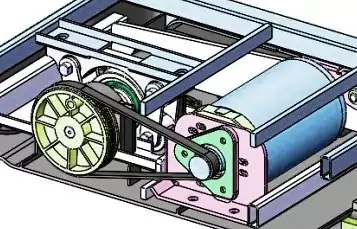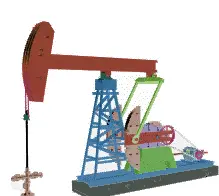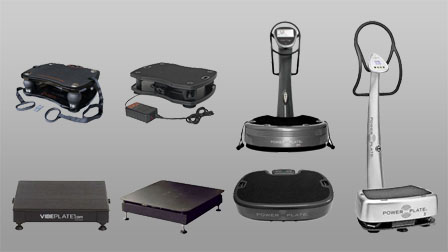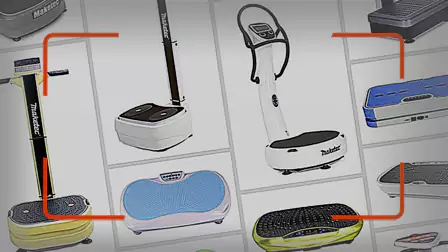Linear Vibration vs Pivotal Oscillation

Linear vibration plates and pivotal oscillation plates are the two most common types of vibration plates.
Their mechanics and vibration characteristics are distinctly different, as are their impacts on the body and the reactions from the body.
In this page we compare these two types of vibration plates about their mechanics, vibration parameters, impact to body and potential benefits.
Content Index
- Vibration Characteristics
- Linear Vibration Plate
- Pivotal Oscillation Plate
- Effects on Body
- Potential Benefits
- Mechanical Attributes
- Linear Vibration Models
- Pivotal Oscillation Models
- Buying Guide
Vibration Characteristics Comparison
| Linear Vibration | Pivotal Oscillation |
|---|---|
| Mechanics & Movement Pattern | |
 |
 |
| Eccentric Wheel Device | Planar Four-Bar Device |
| Vertical Movement | Seesaw Movement |
| Vibration Parameters | |
| High Frequency Low Amplitude |
Low Frequency High Amplitude |
| Example Models | |
| Model VT007 Linear Vibration Plate Frequency: 10-40Hz Amplitude: 0.7 - 2.6mm  |
Model VT027 Pivotal Oscillation Plate Frequency: 5-14Hz Amplitude: 10mm 
|
Linear Vibration Plate

Linear vibration plate uses an eccentric wheel device and a spring mechanism to produce forced vibration.
The phrase "linear" comes from the attribute of the spring: the applied force and the displacement (amplitude) has a linear relationship.
Actuator: Eccentric Wheel Device

Eccentric wheel devices are the most widely adopted vibration actuators, commonly used in applications ranging from consumer products like cell phones to industrial equipment such as vibratory compactors.
In a linear vibration plate, a set of eccentric wheels rotate and create circular centrifugal force. The force drives the platform to move in a vertical oval path. The supporting springs regulate the exercise platform to move mainly in vertical direction and less in horizontal direction.

Section View of VT003F
Linear vibration plates are typically designed to operate within a frequency range of 15Hz to 40Hz and an amplitude range of less than 3mm.
Power Plate models, VibePlate models and Vibration Therapeutic model VT003F, VT007 and VT009 are all linear vibration plate models
Pivotal Oscillation Plate

Pivotal oscillation plate uses a planar four-bar linkage device to produce its reciprocating movement.
The exercise platform of pivotal oscillation plate moves like a seesaw around a center pivot axis ~ literally, pivotal oscillation.
Actuator: Planar Four-Bar Linkage

Planar Four-Bar Linkage
Planar four-bar devices are among the most efficient actuators for converting rotation movement into reciprocating movement.
In a pivotal oscillation plate, the motor drives the crank-bar (red) via a belt. The crank-bar, designed with a circular shape, allows smooth rotation by the belt. This rotation is transmitted to the coupler-bar (green) and the rocker-bar (blue). The exercise platform is mounted on the rocker-bar. As the crank-bar rotates, the coupler-bar moves the rocker-bar, causing the exercise platform to oscillate in a seesaw motion.

VT027 4-Bar Device
VT027 pivotal oscillation plate comes with an innovative twin-coupler design, which improves the strength and durability of the movement device, and also allow the machine be designed shorter.
Pivotal oscillation plates are typically designed to operate within a frequency range of 5Hz to 15Hz, with an amplitude ranging from 8mm to 10mm.

Section View of VT027 Pivotal Oscillation Plate
pivotal oscillation plate resembles a jack pump

Pivotal oscillation plate resembles an oil pumpjack, also a four-bar linkage device. Only the pivotal oscillation plate moves much faster.
Pivotal oscillation is actually not vibration. It lacks some characteristics of vibration, like damping.
Manufacturers and sellers commonly refer to pivotal oscillation plates as vibration plates, a term widely accepted in the market.
However, pivotal oscillation differs significantly from linear vibration. For clarity, we refer to it as a pivotal oscillation plate and promote the use of this name.
3D vibration plates also adopt 4-bar devices
Once you understand the movement of a pivotal oscillation plate, it becomes easier to get the idea of a 3D vibration plate. Essentially, a 3D vibration plate combines two pivotal oscillation mechanisms: one generates a seesaw motion, while the other produces lateral (side-to-side) movement.

Seesaw

Lateral

3D
Effects on Human Body
Due to their distinct movement patterns and vibration characteristics, linear vibration plates and pivotal oscillation plates have significantly different physical and physiological effects on the human body.
| Linear Vibration vs Pivotal Oscillation | |
| Linear Vibration | Pivotal Oscillation |
|---|---|
| Body Movement Comparison | |
 |
 |
| Whole-body up and down | Pivotal at waist; lateral at hips. |
| Response to Frequency | |
| Resonant with skeletal muscles | Resonant with the whole body |
| Impact of Amplitude | |
| Small body movement | Large body movement |
| Direct physiological Influence | |
| Fast-pace skeletal muscle contractions. | Less skeletal muscle contractions |
| Negative Impact | |
| Vertical vibration can transmit to upper body, for some individuals, this can cause - Nausea, due to stomach agitation; - Dizziness, due to stimulation to the vestibular system. |
- Large body movements may pose balance challenges for individuals with physical weakness. Using a handrail is highly recommended to ensure safety; - Higher amplitude means higher impact on the knee joints, especially when standing straight on the plate. * |
| Overall Influences | |
| - Less body movement; - Muscles contract in fast pace; - Body pose tense. |
- Intensive body waggle; - Muscles swing vigorously, but stay loose due to less contractions; - Body pose relax |
In fact, squat, deadlift, tiptoe, and calf raise are the most suitable exercises on a vibration plate. These exercises effectively target the muscles of the lower limbs while minimizing stress on the knee joints.
Body Movement
Linear Vibration
The vertical acceleration created by a linear vibration plate elevates the gravitational forces, effectively stimulating skeletal muscle contractions. If stand straight, the vertical vibrations can transmit to the upper body.
Squat, calf-raise and tiptoe are the most effective exercises to perform on a linear vibration plate. These exercises allow you to control or prevent vibration from being transmitted to the upper body.
Pivotal Oscillation
The seesaw movement of a pivotal oscillation plate causes the body to swing from side to side, with the feet moving up and down in alternation. The lateral motion peaks at the hips, creating a secondary pivot axis at the waist that corresponds to the pivot axis on the oscillation plate, preventing movement from being transferred further up to the upper body.
Pivotal oscillation results in less muscle contractions.
Response to Frequency
Linear Vibration
The frequency range of a linear vibration plate (usually 15-40Hz) aligns with the natural frequency range of skeletal muscles (15-30Hz), creating a resonance effect with muscles and causing more enhanced muscle contractions.
Skeletal muscles actively damp the vibration and become tense in the process. The whole body remains rigid and stable, not moving with the vibration.
Pivotal Oscillation
The frequency range of a pivotal oscillation plate (5-15Hz) aligns with the whole body's natural frequency range (4-8Hz). Pivotal oscillation plate can create a resonance effect with the whole body. This cause the body to waggle intensively.
Skeletal muscles also swing vigorously, but with less muscle contractions. The muscles remain loose and relaxed.
Impact of Amplitude
Linear Vibration
The lower vertical amplitude of a linear vibration causes small range of body motion, but effectively induce skeletal muscle contractions.
Pivotal Oscillation
The higher amplitude seesaw movement from a pivotal vibration plate results in a greater range of body motion but is less effective at inducing skeletal muscle contractions.
Physiological Influence
Linear Vibration
Linear vibration induces rapidly repeated skeletal muscle contractions that effectively exercise the musculoskeletal system, activate the neuromuscular system, and through skeletal muscle pump effect, promote peripheral circulation.
Pivotal Oscillation
Pivotal Oscillation induces less muscle contractions, but the vigorous shake on the body may influence other body system, such as parasympathetic nervous system and endorphin system.
Negative Impact
Linear Vibration
Vertical vibrations from a linear vibration plate can reach the upper body, potentially affecting the stomach and head, which may cause nausea and dizziness in some individuals.
Squats, calf raises, tiptoes, and deadlifts are the most effective exercises to perform on a linear vibration plate. These exercise poses prevent vibration from being transferred to the upper body.
Pivotal Oscillation
A pivotal oscillation plate with a higher seesaw movement amplitude can cause the body to swing vigorously, leading to large lateral displacement. This may pose balance challenges for individuals who are physically weak.
To enhance stability, consider using a wall-mounted handrail or holding onto a sturdy piece of heavy furniture.
Overall Influences
Linear Vibration
A linear vibration plate generates low-amplitude vertical movements that result in minimal body motion but induce rapidly repeated skeletal muscle contractions. The resonance effect on muscles amplifies this stimulation, enhancing the overall contraction response.
As a result of muscle contractions, the muscles become tight, and the body's posture becomes tense.
Pivotal Oscillation
A pivotal oscillation plate generates high-amplitude seesaw movements that cause the entire body to sway. This motion's intensity is enhanced by the resonance effect on the body. Although the muscles oscillate vigorously, they remain loose due to limited contractions, allowing the entire body and muscles to stay relaxed.
Potential Benefits
Both linear vibration plates and pivotal oscillation plates deliver stimulation to muscles, bones, tendons, and ligaments, enhancing circulation and activating nerve and endocrine functions. However, due to their distinctive movement patterns and vibration characteristics, their effects vary significantly and concentrate on different areas.
Linear vibration plates are best suited for enhancing muscle engagement and supporting intense exercise routines, while pivotal oscillation plates are ideal for promoting relaxation and relieving stress.
Disclaimer
Our statements, and recommendations have not been reviewed, approved, or endorsed by healthcare professionals, institutions, or regulatory authorities. Our vibration plates are sold as exercise equipment and are not classified as medical devices.
Vibration can have adverse effects on your body. You are responsible for choosing to use our vibration plate and for how you use it.
We strongly suggest you to consult fitness and medical professionals before participating in this research trial program.
Benefits of Linear Vibration
Linear vibration plates can effectively exercise the musculoskeletal system, engaging muscles, bones, tendons, and ligaments. This helps relieve muscle pain, improve muscle quality, promote bone growth, and support rehabilitation exercises for muscle and tendon injuries.
Additionally, linear vibration plates can activate and train the neuromuscular system, improving its overall functionality. It has shown to quickly improve conditions like peripheral neuropathy.
Through the skeletal pump effect, linear vibration enhances peripheral circulation and microcirculation for blood and lymph.
Benefits of Pivotal Oscillation
The low-frequency oscillations gently loosen tight or stiff muscles, promoting a calming effect on both the body and mind.
The slow oscillations also stimulate the parasympathetic nervous system, which, when activated, induces a physiological calming response that may reduce anxiety and prepare the body for restful sleep.
Additionally, rhythmic vibrations can encourage the release of endorphins, helping to reduce stress, elevate mood, and foster a sense of well-being.
With regular use, a pivotal oscillation plate may help lower cortisol levels, the stress hormone, by promoting relaxation and enhancing overall mood.
Mechanical Attributes
Flexible Link vs Rigid Link
Linear Vibration Plate

VT003F structure
Linear vibration plate has a flexible link structure. Due to its spring mechanism, its amplitude yields to the body weight.
The flexible link structure restricts the achievable displacement. At higher frequency, the damping effect of the vibration further limits the amplitude.
Therefore linear vibration plates are designed for low amplitude applications.
Pivotal Oscillation Plate

VT027 Metal Structure
Pivotal oscillation plate has a rigid link structure, a rigid four bar mechanism. Therefore its oscillation amplitude is fixed, regardless the body weight.
Rigid link structure puts higher stress to the mechanical components, which can wear out faster at higher frequency.
Therefore pivotal oscillation plates are usually designed to for low frequency applications.
Motor Power
Linear Vibration Plate
Theoretically, for a linear vibration plate, the motor's power consumption remains nearly constant and is unaffected by the user's body weight. This design allows linear vibration plates to operate with smaller motors, as they do not require additional tolerance to accommodate power surges.
For instance, the VT007 linear vibration plate is equipped with an 80W motor, which provides sufficient power to drive its eccentric wheel mechanism. Even larger vibration plates, such as the Power Plate My3, have a rated motor power of only 160W, demonstrating the efficiency of this design.
Pivotal Oscillation Plate
For a pivotal oscillation plate, the user's body weight directly impacts the motor's power consumption. Additional motor power capacity is required to handle sudden load increases, such as when the user's weight shifts to one side of the platform. This ensures the motor is protected by accounting for power surge tolerance.
For a pivotal oscillation plate operating at a maximum frequency of 15Hz and an amplitude of 10mm, designed for users weighing up to 265 lbs, a 200W motor is typically sufficient.
Speed compensation of pivotal oscillation plate
VT027 pivotal oscillation plate is designed to compensate the speed when the machine is running at low frequency and there is a load surge, such as the user has the entire body weight on one side of the pivotal oscillation plate. This design is to protect the motor by reducing the electric current in the rotor coil.
The speed change is more evident when the machine oscillate at lower frequency.
For example, at 5Hz frequency, if you put your entire body weight on one side of the VT027, the machine is programmed to speed up the oscillation. You will actually get 8 Hz instead.
Linear Vibration Models
There are relatively few linear vibration plate models available in the market. Among them, Vibration Therapeutic offers compact size VT003F and VT007 models, while brands like Power Plate and VibePlate provide larger models primarily designed for commercial use.
Some linear vibration plate models, such as the VT003F and VT007, feature adjustable frequencies ranging from 15Hz to 40Hz and offer two amplitude settings. Others, however, are designed with a fixed frequency, typically set between 30Hz and 35Hz.
Certain VibePlate models are designed to operate at frequencies as high as 60Hz.
Despite the variety in frequency settings, all linear vibration plates share a common feature: they are designed to operate with low amplitude, typically below 3mm.

Linear Vibration Plate Models
Pivotal Oscillation Models
There are numerous pivotal oscillation plate models available in the market, commonly referred to as vibration plates, with most being sold on ecommerce platforms like Amazon and Walmart.
The majority of these vibration plates are white-label products, often derived from a limited number of generic OEM designs produced in China. These include models presented by LifePro, AXV, Eilison, and others sellers on Amazon that don't clearly identify themselves.
The VT027 pivotal oscillation plate features a patented twin-coupler four-bar device which greatly improves its mechanical performance and durability.
Most pivotal oscillation plates offer adjustable frequency, typically capped at 15Hz or below.

Pivotal Oscillation Plates
3D and 4D vibration plates are essentially pivotal oscillation plates. They have two four-bar linkage devices combined to produce complex pivotal oscillations.

3D Vibration Plate
The Only High Frequency Pivotal Oscillation Plate
While most pivotal oscillation plates operate at frequencies below 15Hz, German-made Galileo pivotal oscillation models are the only exception.

10-30Hz
Galileo S25 can achieve a 30Hz high frequency and a 8mm peak-to-peak amplitude (G-force = 7.2).
Another Galileo model S40 can achieve 33Hz and 9.4mm amplitude. Being both high frequency and high amplitude, the model S40 can achieve a G-force of 10.3, probably the highest among all vibration plates available in the market.
The requirements of machining precision and material performance make it costly to make a durable pivotal oscillation model to run at higher frequency (above 15Hz). Low quality bearings can quickly wear out, and low performance material coupler-bar can reach fatigue much sooner. That is the reason that this type of high frequency and high amplitude pivotal oscillation plates are only made in Germany.
Vibration Plate Buying Guide
For comprehensive product knowledge and insights into various types of vibration plates, click the link below to explore our Vibration Plate Buying Guide.

